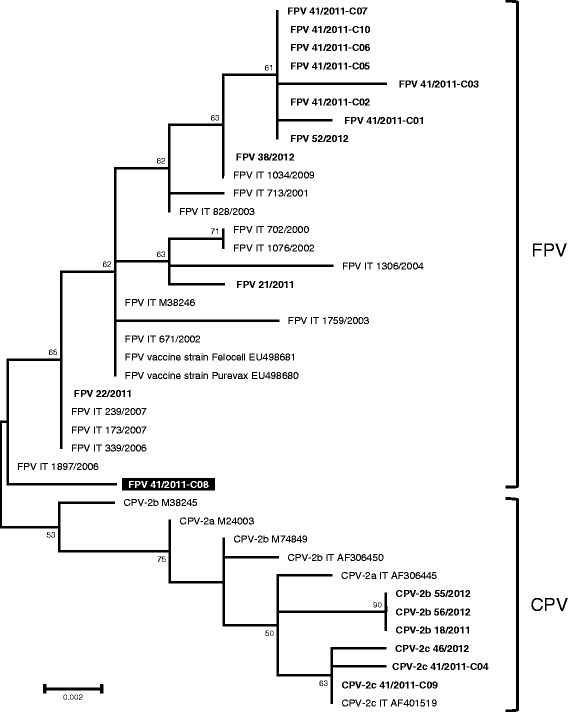Molecular analysis of carnivore Protoparvovirus detected in white blood cells of naturally infected cats
- PMID: 29402272
- PMCID: PMC5799907
- DOI: 10.1186/s12917-018-1356-9
Molecular analysis of carnivore Protoparvovirus detected in white blood cells of naturally infected cats
Abstract
Background: Cats are susceptible to feline panleukopenia virus (FPV) and canine parvovirus (CPV) variants 2a, 2b and 2c. Detection of FPV and CPV variants in apparently healthy cats and their persistence in white blood cells (WBC) and other tissues when neutralising antibodies are simultaneously present, suggest that parvovirus may persist long-term in the tissues of cats post-infection without causing clinical signs. The aim of this study was to screen a population of 54 cats from Sardinia (Italy) for the presence of both FPV and CPV DNA within buffy coat samples using polymerase chain reaction (PCR). The DNA viral load, genetic diversity, phylogeny and antibody titres against parvoviruses were investigated in the positive cats.
Results: Carnivore protoparvovirus 1 DNA was detected in nine cats (16.7%). Viral DNA was reassembled to FPV in four cats and to CPV (CPV-2b and 2c) in four cats; one subject showed an unusually high genetic complexity with mixed infection involving FPV and CPV-2c. Antibodies against parvovirus were detected in all subjects which tested positive to DNA parvoviruses.
Conclusions: The identification of FPV and CPV DNA in the WBC of asymptomatic cats, despite the presence of specific antibodies against parvoviruses, and the high genetic heterogeneity detected in one sample, confirmed the relevant epidemiological role of cats in parvovirus infection.
Keywords: Canine parvovirus; Cat; Coinfection; Feline panleukopenia virus; PCR; White blood cells.
Conflict of interest statement
Ethics approval
The study was carried out using stored blood samples which had been collected for clinical and laboratory purposes independent of the study with the agreement of the cat owners who presented their cats to the Veterinary Teaching Hospital (University of Sassari). As stored blood samples were used, no separate ethical approval was required for the study. All efforts were made to minimise the discomfort of the animals during sampling.
Consent for publication
Not applicable.
Competing interests
The authors declare that they have no competing interests.
Publisher’s Note
Springer Nature remains neutral with regard to jurisdictional claims in published maps and institutional affiliations.
Figures

References
-
- International Committee on Taxonomy of Viruses ICTV. http://ictvonline.org/virustaxonomy.asp. Accessed 23 Mar 2017.
-
- Miranda C, Vieira MJ, Silva E, Carvalheira J, Parrish CR, Thompson G. Genetic analysis of feline Panleukopenia virus full-length VP2 gene in domestic cats between 2006-2008 and 2012-2014, Portugal. Transbound Emerg Dis. 2016. 10.1111/tbed.12483. - PubMed
MeSH terms
Substances
LinkOut - more resources
Full Text Sources
Other Literature Sources
Miscellaneous

